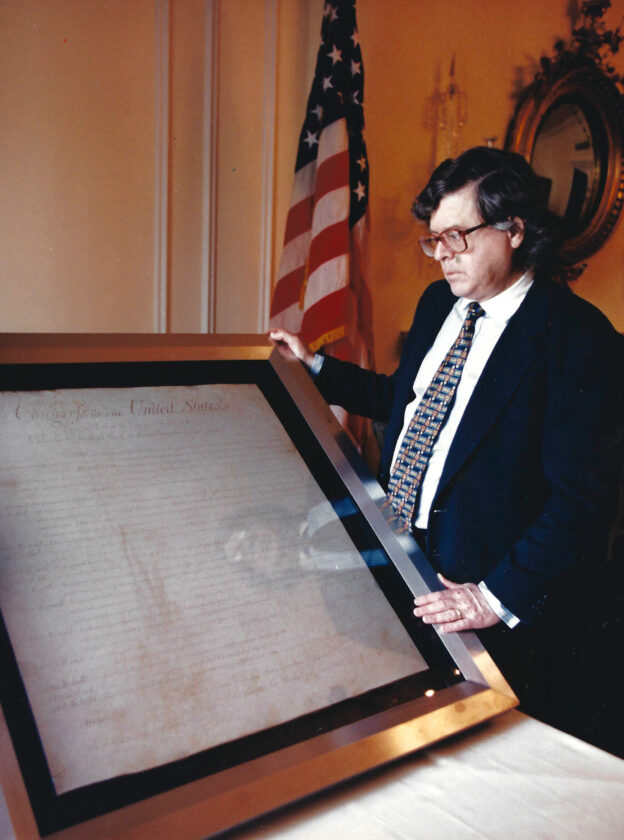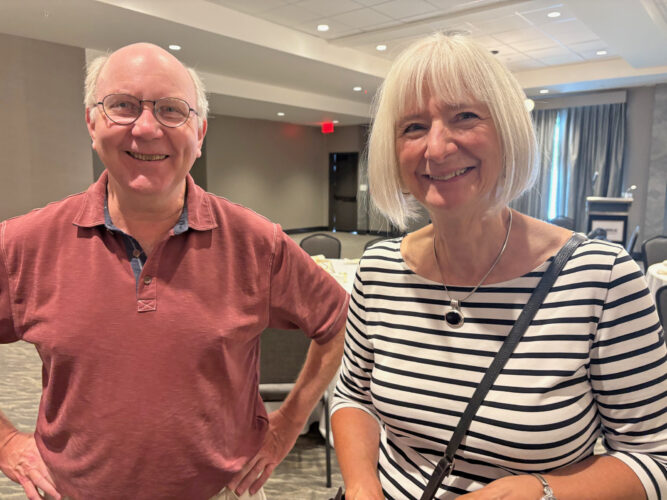WORLD FOCUS: Saving the ‘Charters of Freedom’

Dr. Joel S. Levine is seen with the Bill of Rights, the first 10 amendments to the United States Constitution. (Provided photo)
Patriotism has always been at the core of Lake Plaid’s identity. This community has always embraced and celebrated Americans’ achievements in sports and other fields of human endeavor.
Saving the “Charters of Freedom” is one of them.
It was more than 200 years ago that the most important documents in the history of the United States have been created. They are the Declaration of Independence (1776), the U.S. Constitution (1789) and the Bill of Rights (1789), collectively called the “Charters of Freedom.”
They are hand-written documents on sheepskin parchment and displayed in hermetically sealed glass encasements in the Visitor’s Rotunda of the National Archives and Records Administration building in Washington, D.C. Each year, more than a million visitors view those historic documents.
In 1951, to preserve and protect the documents from the chemical deteriorating effects of air, the air in the encasement was evacuated and replaced with a mixture of helium and water vapor at a relative humidity between 25 and 35 percent at room temperature. Helium, an inert gas, is chemically safe for documents and the water vapor is needed to maintain the stability of the sheepskin parchment documents.
In July 1998, Margaret A.T. Kelly, a chemist at the National Archives and Records Administration, called Dr. Joel S. Levine, then a senior research scientist at the NASA Science Directorate, of the NASA Langley Research Center, Hampton, Virginia, to request assistance in measuring the chemical composition of the atmosphere inside the encasements containing the historic documents. Levine is now a Research Professor in the Department of Applied Science at William & Mary.
Levine is an atmospheric and planetary scientist, whose area of research is the chemical composition of the atmosphere of the Earth and Mars.
Ms. Kelly informed Levine that over the last few years some experts in documents preservation community have questioned the stability of the helium/water vapor atmosphere in the encasements. NARA was very interested in determining whether the atmosphere in the seven encasements still contained the original 1951 gaseous mixture or it has leaked out and was replaced by chemically corrosive air.
The atmosphere in the hermetically sealed encasement between the documents and the glass covering was only several millimeters thick, making measurements of the atmosphere of me chemical composition extremely difficult with conventional non-invasive measurement techniques.
After securing the approval of NASA Langley Center director, Levine formed a NASA research team of chemist, physicist and engineers to measure the chemical composition of the encasement, the NASA research team used a NASA-developed laser spectrometer designed to measure trace gases in planetary atmosphere, and developed a a brand-new measurement technique to measure the water vapor content of the encasements that they named the “cooling/condensation” technique, Using the two non-invasive measurement techniques, the NASA team discovered that the encasement contained water vapor with a relative humidity ranging from 55 to 64%, considerably higher than the 25 to 35% originally sealed in the encasement in 1951.
Over the last decade, the higher level s of water vapor in the encasement caused a chemical reaction with the encasement glass, causing the glass to leach out alkaline material that formed tiny spots on the documents. It was detected by NARA conservators upon close visual inspection of the “Charters of Freedom.”
It was later hypothesized that the significant increase in the water vapor content of the encasement resulted from the “outgassing” of the water vapor that was originally absorbed in the backing paper that the documents were placed on. The “outgassing” of the absorbed water vapor in the backing paper into the encasement atmosphere took bout 50 years.
NARA removed the documents from their original 1951 encasements and sealed them in a brand-new encasement. It was built by the National Institute of Standards and Technology. The documents are sealed in an atmosphere of chemically inert argon and water vapor at a relative humidity of 25 to 35%. A water vapor measurement instrument is installed in each encasement to continually monitor the water vapor content.
NASA’s assistance in preserving the “Charters of Freedom” documents, is seen as an additional accomplishment by its scientist and engineers.
Dr. Levine, during his 41-year NASA career, was closely involved in planning the first human mission to Mars, and was appointed the Chief Scientist for a NASA rocket -powered robotic airplane that will one day fly through the atmosphere of Mars. He also worked on the world’s first successful soft-landing on planet Mars in 1976 and co-chaired the NASA committee planning the first one day fly through the atmosphere of Mars. In 2010, Levine was part of NASA Chilean Miner Rescue Team that designed the escape capsule that successfully freed 33 Chilean miners trapped in a mine 2,300 feet below the surface.
Considering his career as a scientist at NASA, I asked Dr. Levine, which accomplishment he considers to be for him the most rewarding.
After some pondering, he said, “Helping to preserve the Charters of Freedom!”
(Frank Shatz is a former resident of Lake Placid and a current resident of Williamsburg, Virginia. He is the author of “Reports from a Distant Place,” a compilation of his columns. This column is used with permission by the Virginia Gazette.)



